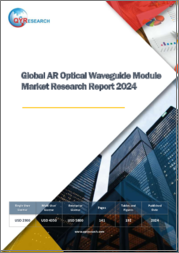
|
시장보고서
상품코드
1808428
세계의 광도파로 시장 예측 : 유형, 재료, 모드 구조, 전파, 제조 기술, 용도, 최종 사용자, 유통 채널별(2025-2030년)Optical Waveguide Market by Type, Material, Mode Structure, Propagation, Fabrication Technology, Application, End User, Distribution Channel - Global Forecast 2025-2030 |
||||||
광도파로 시장의 2024년 시장 규모는 58억 1,000만 달러로 평가되었고, 2025년에는 CAGR 7.83%로 62억 6,000만 달러로 성장하고, 2030년에는 91억 5,000만 달러에 이를 것으로 예측되고 있습니다.
| 주요 시장 통계 | |
|---|---|
| 기준 연도 2024년 | 58억 1,000만 달러 |
| 추정 연도 2025년 | 62억 6,000만 달러 |
| 예측 연도 2030년 | 91억 5,000만 달러 |
| CAGR(%) | 7.83% |
광도파로는 현대 포토닉 시스템의 핵심을 이루며, 제한된 경로를 최소한의 손실로 효율적으로 빛을 전송할 수 있습니다. 그 핵심이 되는 광도파로는 광자를 설계된 재료를 통해 인도하는 것으로, 다양한 파장의 전자파를 조작합니다. 이 기본 기능은 고속 데이터 전송에서 까다로운 환경에서 정밀한 감지에 이르기까지 다양한 용도를 지원합니다.
광도파로의 동작을 지배하는 물리학은 전체 내부 반사와 굴절률 대비의 원리에 의존합니다. 재료 인터페이스와 기하학적 설계를 활용하여 도파관은 장거리와 복잡한 레이아웃에서도 신호 무결성을 유지합니다. 제조 기술의 진보로 모드 가두기, 분산 특성 및 스펙트럼 대역폭 제어가 더욱 정교해졌으며 새로운 이용 사례의 성능 요구 사항을 충족하기 위한 사용자 정의가 가능해졌습니다.
증가하는 데이터 양을 배경으로 높은 대역폭과 에너지 효율 추구는 광도파로를 산업 혁신의 중심에 두고 있습니다. 재료 과학자, 포토닉 엔지니어 및 시스템 통합사업자의 협업은 지속적으로 획기적인 추진을 추구하며 컴팩트하고 고기능의 포토닉 회로의 진화를 촉진하고 있습니다. 생태계가 확대되는 동안 이해관계자는 차세대 포토닉 연결 솔루션의 잠재력을 완전히 실현하기 위해 복잡한 기술, 규제, 시장 역학을 탐색해야 합니다.
또한 광 집적 회로의 광 도파관과 전자 부품의 융합은 디바이스 아키텍처를 재정의하여 설치 공간과 전력 소비를 줄이고 있습니다. 이 시너지 효과는 데이터센터, 통신 인프라, 자율 주행 차량용 라이더 등 신흥 시장의 요구에 대응하는 데 도움이 됩니다. 포토닉 플랫폼이 성숙함에 따라 업계는 성능과 기능의 새로운 영역을 개척하고 혁신적인 용도로 가는 길을 열어 나가고 있습니다.
광도파로 시장을 형성하는 혁신적인 변화
최근 광도파로의 상황을 다방면에서 재정의하는 일련의 변혁적 시프트가 일어나고 있습니다. 재료 과학의 획기적인 발전은 전례 없는 투명성과 기계적 탄력성을 실현하는 새로운 유리 조성과 폴리머 블렌드를 도입했습니다. 병행하여 실리콘 기반 포토닉스의 출현으로 도파관과 반도체 공정의 통합이 가속화되어 재현성이 높은 소형 디바이스의 대량 생산이 가능해졌습니다.
광도파로 공급망 생산 경제성과 세계 경쟁력에 대한 2025년 미국 관세 조정의 누적 영향
2025년에 도입된 미국 관세 정책의 변화는 업계 전반의 광도파로 공급망과 경제 모델에 큰 영향을 미칩니다. 재료, 부품 및 완성 모듈의 관세 조정은 조달 전략을 검토하고 제조업체는 대체 조달 경로를 모색해야합니다. 이 방향 전환은 비용 구조를 재구성하고 관세 부담을 줄이기 위해 특정 생산 단계를 주요 시장 근처로 이전하도록 촉구합니다.
광도파로 시장 역학을 밝혀내는 종합적인 세분화 통찰 : 유형 재료 모드 구조 전파 제조 기술 용도와 최종 사용자의 차원에 걸쳐
세분화 분석은 광 도파관의 구성이 기술적, 재료적으로 다른 기준에 의해 형성되는 것으로 나타났습니다. 광도파로의 유형별로 보면 평면 집적용으로 설계된 채널 도파로, 장거리 전송용으로 조정된 파이버 도파로, 밴드 갭 엔지니어링을 제공하는 포토닉 결정 구조, 온칩 배선용으로 최적화된 평면 도파로, 가두기와 제조 용이성의 균형을 맞춘 리브 도파로, 컴팩트한 실적와 높은 인덱스 각 카테고리는 특정 성능 지표를 지원하며 최종 용도 시나리오에서 다양한 채택 패턴을 추진하고 있습니다.
아시아태평양의 광도파로 시장 역학의 주요 하이라이트 성장 촉진요인과 전략적 과제
아메리카에서는 데이터센터 인프라에 대한 왕성한 투자와 고속통신 백본의 확대가 호조적인 원동력이 되고 있습니다. 북미의 연구기관과 기술 허브가 실리콘 포토닉스의 혁신을 추진하고, 지역 제조업체는 전략적 파트너십을 맺어 국내 생산 능력을 강화하고 있습니다. 첨단 제조업과 안전한 공급망을 지원하는 정부 이니셔티브는 도파로 기술 혁신의 이 지역 리더십을 더욱 강화하고 있습니다. 중남미 시장은 신흥 시장이면서 농업과 환경 모니터링을 위한 센싱 용도에 대한 관심이 높아지고 있어 확대 가능성을 시사하고 있습니다.
전략적 이니셔티브를 밝히는 주요 기업의 경쟁 인사이트 세계 주요 광도파로 산업 이해 관계자의 공동 파트너십과 혁신의 궤적
업계를 선도하는 기업을 조사한 결과 시장에서의 존재감을 높이고 기술 진보를 가속화하는 것을 목표로 한 전략적 추구의 태피스트리가 밝혀졌습니다. 일부 선도 기업들은 차세대 도파관 재료 개발에 많은 투자를 하고 있으며, 비선형 광학 및 저손실 기판의 새로운 연구를 활용하기 위해 학술기관과 제휴를 맺고 있습니다. 이러한 협력 관계는 독자적인 포트폴리오를 강화하고 경쟁이 심한 분야에서 차별화를 촉진하고 있습니다.
진화하는 광도파로 생태계의 전략적 파트너십과 지속 가능한 성장을 위해 업계 리더를 이끄는 실행 가능한 제안
업계 지도자는 새로운 성능 요구 사항을 충족시키기 위해 고급 재료 플랫폼 통합을 우선해야 합니다. 대학 및 전문 연구소와 협력하여 전용 연구 프로그램을 수립함으로써 기업은 새로운 기판 및 복합재료 개념에서 생산 준비로의 전환을 가속화할 수 있습니다. 리소그래피 정밀도와 적층 제조 능력을 결합한 유연한 제조 모델을 채택함으로써 신속한 커스터마이징과 비용 절감이 가능합니다.
광도파로 시장 분석을 지원하는 체계적인 데이터 수집 분석 프레임 워크
본 분석을 뒷받침하는 조사 방법은 종합적인 2차 조사와 치밀한 1차 조사를 조합하여 통찰의 깊이와 정확성을 모두 확보하고 있습니다. 우선 기초 지식을 확립하고 새로운 동향을 파악하기 위해 기술 잡지, 특허 데이터베이스, 규제 당국에 신고, 업계 출판물을 폭넓게 검토했습니다. 이 2차 조사에서는 재료의 혁신, 제조의 진보, 용도의 변화 등의 배경이 밝혀졌습니다.
결론 광도파로 기술의 미래를 탐색하는 업계 이해관계자들에게 새로운 기회와 전략적 전망을 보여주는 중요한 통찰 요약
광도파로가 계속 진화하는 동안, 파동 전파와 재료 과학의 기본 원리는 여전히 혁신의 핵심입니다. 첨단 재료, 정교한 제조 기술, 응용 분야의 요구가 증가함에 따라 광 기능의 새로운 시대를 견인하고 있습니다. 이러한 혁신적인 변화는 세계 무역역학, 특히 공급망과 비용 구조를 재구성하는 관세 조정의 영향을 받습니다.
목차
제1장 서문
제2장 조사 방법
제3장 주요 요약
제4장 시장 개요
제5장 시장 역학
- 광도파로에 실리콘 포토닉스의 통합에 의한 데이터 전송 용량의 향상
- 유연하고 비용 효율적인 광 상호 연결 솔루션을위한 폴리머 기반 도파관 채택
- 장거리 고속 통신 네트워크용 저손실 중공 코어 광섬유 도파로 개발
- 데이터센터용도에 있어서의 광도파로를 활용한 집적광회로의 확장
- 신속한 프로토타이핑 및 맞춤형 설계를 위한 3차원 도파관 인쇄 기술의 발전
- 차세대 코히런트 광전송을 서포트하는 고굴절률 콘트라스트 도파로의 실장
- 실시간 의료 진단용 바이오센싱 플랫폼에 있어서의 실리콘 질화물 도파로의 사용 증가
- 소비자용 전자기기나 자동차 LiDAR 시스템에 있어서의 광대역 멀티 모드 도파로 수요 증가
- 나노스케일의 가두기와 변조를 실현하기 위한 하이브리드 플라즈모닉 도파로 구조의 새로운 역할
- 온도 변화에 대하여 안정된 성능을 확보하기 위한 수동 열 도파관 설계 최적화
제6장 시장 인사이트
- Porter's Five Forces 분석
- PESTEL 분석
제7장 미국 관세의 누적 영향 2025년
제8장 광도파로 시장 : 유형별
- 채널 도파로
- 섬유 도파로
- 포토닉 결정
- 평면 도파로
- 리브 도파로
- 스트립 도파로
제9장 광도파로 시장 : 재료별
- 유리
- 폴리머
- 실리콘
제10장 광도파로 시장 : 모드 구조별
- 단계적 지수
- 스텝 인덱스
제11장 광도파로 시장 : 전파별
- 멀티 모드
- 싱글 모드
제12장 광도파로 시장 : 제조 기술
- 리소그래프
- 비리소그래피
제13장 광도파로 시장 : 용도별
- 데이터 전송
- 통합 광학
- 광통신 시스템
- 광집적 회로
- 센싱
제14장 광도파로 시장 : 최종 사용자별
- 자동차 제조업체
- 방위 및 항공우주
- 전자기기 제조업체
- 의료 제공자
- 통신 사업자
제15장 광도파로 시장 : 유통 채널별
- 오프라인
- 직접 판매
- 유통업체 및 리셀러
- 온라인
제16장 아메리카의 광도파로 시장
- 미국
- 캐나다
- 멕시코
- 브라질
- 아르헨티나
제17장 유럽, 중동 및 아프리카의 광도파로 시장
- 영국
- 독일
- 프랑스
- 러시아
- 이탈리아
- 스페인
- 아랍에미리트(UAE)
- 사우디아라비아
- 남아프리카
- 덴마크
- 네덜란드
- 카타르
- 핀란드
- 스웨덴
- 나이지리아
- 이집트
- 튀르키예
- 이스라엘
- 노르웨이
- 폴란드
- 스위스
제18장 아시아태평양의 광도파로 시장
- 중국
- 인도
- 일본
- 호주
- 한국
- 인도네시아
- 태국
- 필리핀
- 말레이시아
- 싱가포르
- 베트남
- 대만
제19장 경쟁 구도
- 시장 점유율 분석, 2024년
- FPNV 포지셔닝 매트릭스, 2024년
- 경쟁 분석
- Aksh OptiFibre Ltd.
- Birla Cable Ltd.
- Coherent Corp.
- CommScope, Inc.
- Corning Incorporated
- DigiLens Inc.
- Fujikura Ltd.
- Furukawa Electric Co., Ltd.
- Futong Group Company Ltd.
- Himachal Futuristic Communications Ltd.
- Holographix LLC
- Infinite Cables Inc.
- Lumus Ltd.
- M2Optics, Inc.
- Mitsubishi Chemical Group Corporation
- Multicom, Inc.
- NEC Corporation
- OFS Fitel, LLC
- Optical Cable Corporation
- Prysmian SpA
- SAB Brockskes GmbH & Co. KG
- Shanghai Tangpin Technology Co., Ltd.
- Shenzhen Sopto Technology Co., Ltd.
- Sterlite Technologies Limited
- Structured Cable Products Inc.
- Sumitomo Electric Industries, Ltd.
- Focuslight Technologies Inc.
- Teem Photonics
- The Light Connection, Inc.
- Wave Optics Ltd.
- Waveguide Optical Technologies
제20장 리서치 AI
제21장 리서치 통계
제22장 리서치 컨택
제23장 리서치 기사
제24장 부록
SHW 25.09.22The Optical Waveguide Market was valued at USD 5.81 billion in 2024 and is projected to grow to USD 6.26 billion in 2025, with a CAGR of 7.83%, reaching USD 9.15 billion by 2030.
| KEY MARKET STATISTICS | |
|---|---|
| Base Year [2024] | USD 5.81 billion |
| Estimated Year [2025] | USD 6.26 billion |
| Forecast Year [2030] | USD 9.15 billion |
| CAGR (%) | 7.83% |
Optical waveguides represent the backbone of modern photonic systems, enabling the efficient transmission of light through confined paths with minimal loss. At their core, these structures manipulate electromagnetic waves across a range of wavelengths by guiding photons through engineered materials. This fundamental capability underpins a diverse array of applications, from high-speed data transmission to precision sensing in demanding environments.
The physics governing optical waveguide operation hinge on principles of total internal reflection and refractive index contrast. By leveraging material interfaces and geometric design, waveguides maintain signal integrity over extended distances and complex layouts. Advances in fabrication techniques have further refined control over mode confinement, dispersion characteristics, and spectral bandwidth, allowing customization to meet the performance requirements of emerging use cases.
Against a backdrop of escalating data volume, the quest for higher bandwidth and energy efficiency has positioned optical waveguides at the center of industry innovation. Collaboration between material scientists, photonic engineers, and system integrators continues to catalyze breakthroughs, driving the evolution of compact, high-functioning photonic circuits. As the ecosystem expands, stakeholders must navigate intricate technological, regulatory, and market dynamics to fully realize the potential of next-generation photonic connectivity solutions.
Moreover, the convergence of optical waveguides with electronic components in photonic integrated circuits is redefining device architectures, reducing footprint and power consumption. This synergy is instrumental in addressing the needs of data centers, telecommunications infrastructure, and emerging markets such as lidar for autonomous vehicles. As photonic platforms mature, the industry is poised to unlock new realms of performance and functionality, paving the way for transformative applications.
Transformative Shifts Reshaping Optical Waveguide Market From Revolutionary Material Innovations and Fabrication Techniques to Evolving Application Demands and Strategic Industry Realignments
Recent years have witnessed a series of transformative shifts that are redefining the optical waveguide landscape on multiple fronts. Breakthroughs in material science have introduced novel glass compositions and polymer blends that deliver unprecedented transparency and mechanical resilience. In parallel, the advent of silicon-based photonics has accelerated the integration of waveguides with semiconductor processing, enabling mass production of compact devices with high reproducibility.
Simultaneously, fabrication technologies have evolved beyond traditional lithographic patterning to incorporate advanced etching techniques and additive manufacturing approaches. These innovations have expanded design freedom, permitting the creation of complex three-dimensional waveguide geometries that optimize mode control and integration density. Such capabilities are critical for the deployment of photonic integrated circuits that consolidate multiple optical functions on a single substrate.
Moreover, application-driven demand is steering the market toward specialized waveguide solutions tailored for data transmission, sensing, and integrated optics. The rise of coherent communication networks, autonomous vehicle perception systems, and miniaturized medical diagnostics has elevated performance benchmarks for optical interconnects. Consequently, strategic realignments are emerging as stakeholders forge partnerships, pursue joint development programs, and reposition portfolios to address high-growth arenas. This confluence of material, manufacturing, and market shifts is fostering a dynamic ecosystem where agility and innovation determine leadership.
The accelerating push for sustainability is also influencing waveguide development, with a growing emphasis on eco-friendly materials and energy-efficient designs. Lifecycle considerations are becoming integral, prompting researchers to explore recyclable polymers and low-temperature fabrication to reduce environmental footprint. Together, these transformative shifts are charting a new trajectory for optical waveguide technologies, setting the stage for continued advancement and market evolution.
Cumulative Impact of United States Tariff Adjustments in 2025 on Optical Waveguide Supply Chains Production Economics and Global Competitive Dynamics
Changes in United States tariff policies introduced in 2025 are exerting a significant influence on optical waveguide supply chains and economic models across the industry. Tariff adjustments on materials, components, and finished modules have led to a reassessment of sourcing strategies, compelling manufacturers to explore alternative procurement routes. This reorientation is reshaping cost structures and prompting the relocation of certain production stages closer to key markets to mitigate duty burdens.
In addition, increased duties on imported silicon substrates and specialty glass have heightened upstream pressures, driving vendors to secure long-term agreements with domestic suppliers and invest in localized material development. These measures are designed to ensure continuity of supply and stabilize pricing, offering greater predictability in budget planning. At the same time, international competitors are reevaluating their market entry approaches, with some prioritizing regions unaffected by the new tariffs to sustain growth momentum.
Moreover, the tariff environment has catalyzed collaboration among stakeholders, as joint ventures and strategic alliances emerge to share risk and pool resources. Technology licensing arrangements are also gaining traction, enabling rapid deployment of advanced waveguide designs without the full burden of capital expenditure. As regulatory landscapes continue to evolve, companies are compelled to adopt flexible operational models and resilient networks to navigate shifting trade dynamics. Ultimately, the cumulative impact of the 2025 tariff adjustments underscores the importance of agile supply chain management and strategic diversification in securing competitive advantage.
Comprehensive Segmentation Insights Unlocking Optical Waveguide Market Dynamics Across Type Material Mode Structure Propagation Fabrication Technology Application and End User Dimensions
Segmentation analysis reveals a nuanced spectrum of optical waveguide configurations shaped by distinct technological and material criteria. When examined through the lens of type, solutions encompass channel waveguides designed for planar integration, fiber waveguides tailored for long-haul transmission, photonic crystal structures offering bandgap engineering, planar waveguides optimized for on-chip routing, rib waveguides balancing confinement and fabrication ease, and strip waveguides prized for compact footprint and high index contrast. Each category addresses specific performance metrics, driving diverse adoption patterns across end-use scenarios.
From a material standpoint, the field navigates between traditional glass substrates renowned for low attenuation, polymer variants providing flexibility and cost-efficiency, and silicon platforms enabling seamless compatibility with electronic circuitry. Distinct mode structures further influence design choices, as graded index profiles support smooth mode evolution and reduced dispersion, while step index configurations deliver strong confinement and predictable propagation characteristics. The propagation modality bifurcates into multimode pathways suited for short-reach communication and single mode conduits preferred for high-bandwidth, long-distance links.
Fabrication technology segmentation underscores a dichotomy between lithographic processes, which leverage established semiconductor equipment for high-precision patterning, and non-lithographic techniques that support rapid prototyping and cost-effective production. Application segmentation spans data transmission infrastructures, integrated optics modules, optical communication systems, photonic integrated circuits consolidating multiple functions, and advanced sensing platforms. End user segments extend across automotive manufacturers seeking lidar integration, defense and aerospace sectors prioritizing reliability, electronics manufacturers embedding photonic interconnects, healthcare providers harnessing diagnostic sensors, and telecom operators orchestrating network upgrades. Finally, distribution dynamics encompass offline channels, including direct sales engagements and distributor-reseller networks, alongside online marketplaces accelerating digital procurement.
Key Regional Insights Highlighting Optical Waveguide Market Dynamics Across Americas Europe Middle East and Africa and Asia Pacific Growth Drivers and Strategic Imperatives
In the Americas, strong momentum originates from robust investments in data center infrastructure and expansion of high-speed communication backbones. North American research institutions and technology hubs are driving breakthroughs in silicon photonics, while regional manufacturers are forging strategic partnerships to enhance domestic production capabilities. Government initiatives supporting advanced manufacturing and secure supply chains further reinforce the region's leadership in waveguide innovation. Latin American markets, though emerging, are exhibiting growing interest in sensing applications for agriculture and environmental monitoring, signaling potential avenues for expansion.
Across Europe, the Middle East, and Africa, diverse regional priorities shape market dynamics. European Union directives on digitalization and sustainability are incentivizing the adoption of energy-efficient photonic components, with key players collaborating on cross-border research programs. The Middle East is witnessing strategic investments in optical networks to underpin smart city frameworks and next-generation transportation systems, while Africa's nascent telecom upgrades are creating opportunities for cost-effective waveguide solutions. Regulatory harmonization efforts and public-private partnerships are instrumental in catalyzing growth across this broad and heterogeneous landscape.
In Asia Pacific, the convergence of consumer electronics innovation and industrial automation is fueling demand for compact and high-performance waveguides. Major technology clusters in East Asia are leading advancements in both fabrication and integration, leveraging mature semiconductor ecosystems. Southeast Asian markets are showing rising adoption in healthcare imaging and automotive sensing, supported by favorable policy frameworks and regional manufacturing expansions. Australia's focus on research commercialization and collaboration with academic centers further contributes to a vibrant ecosystem. Together, these regional narratives underscore the importance of tailored strategies that reflect local priorities, infrastructure readiness, and innovation capabilities.
Key Company Insights Unveiling Strategic Initiatives Competitive Positioning Collaborative Partnerships and Innovation Trajectories of Leading Global Optical Waveguide Industry Stakeholders
Oversight of leading industry players reveals a tapestry of strategic pursuits aimed at consolidating market presence and accelerating technology advancement. Several prominent companies are investing heavily in the development of next-generation waveguide materials, forging alliances with academic institutions to harness emerging research in non-linear optics and low-loss substrates. Such collaborations are enhancing proprietary portfolios and driving differentiation in highly competitive segments.
Competitive positioning varies across firms, with some emphasizing end-to-end solutions that integrate waveguides with active photonic components, while others focus on modular offerings optimized for niche applications such as biosensing or quantum communication. A trend toward vertical integration is apparent, as vertically aligned organizations seek to control critical supply chain nodes, from wafer fabrication to final assembly and testing. This approach not only streamlines production but also safeguards intellectual property and quality standards.
Additionally, strategic partnerships and joint ventures are proliferating, enabling participants to share development costs and access new distribution channels. Recent cooperative efforts for regional manufacturing hubs illustrate a collective push to localize production and reduce lead times. Investment initiatives in advanced packaging techniques and automated testing systems underscore the emphasis on scalability and cost efficiency. As companies navigate technological complexities and evolving customer expectations, their innovation trajectories are increasingly shaped by a blend of in-house R&D and external collaborations, laying the groundwork for sustainable competitive advantage.
Actionable Recommendations Guiding Industry Leaders Toward Operational Excellence Technological Advancement Strategic Partnerships and Sustainable Growth in the Evolving Optical Waveguide Ecosystem
Industry leaders should prioritize the integration of advanced material platforms to address emerging performance requirements. By establishing dedicated research programs in partnership with universities and specialized laboratories, organizations can accelerate the transition of novel substrates and composites from concept to production readiness. Embracing flexible fabrication models that combine lithographic precision with additive manufacturing capabilities will enable rapid customization and cost reduction.
Supply chain resilience must also be reinforced through geographic diversification and the establishment of strategic sourcing agreements. Companies are advised to develop contingency plans that include dual-sourcing of critical materials and component subassemblies to buffer against tariff-related disruptions and logistical bottlenecks. Additionally, investing in digital supply chain visibility tools can enhance risk management and facilitate real-time decision making.
Collaborative ecosystems represent another key lever for market success. Engaging in consortia and cross-industry alliances can extend access to complementary expertise, expedite standardization efforts, and create pathways for co-development of specialized solutions. In parallel, firms should explore opportunities to integrate waveguide technologies into emerging application domains such as quantum computing and biomedical diagnostics, positioning themselves at the forefront of next-wave innovation.
Finally, equipping workforces with specialized photonic engineering skills is vital for sustaining competitiveness. Implementing targeted training initiatives, alongside immersive workshops and certification programs, will cultivate the talent needed to operate complex manufacturing platforms and drive continuous improvement. Through these actionable measures, industry leaders can chart a course toward operational excellence, technological leadership, and long-term growth.
Robust Research Methodology Detailing Systematic Data Collection Analytical Frameworks Primary and Secondary Research Approaches and Validation Processes Underpinning Optical Waveguide Market Analysis
The research methodology underpinning this analysis combines comprehensive secondary research with targeted primary engagements to ensure both depth and accuracy of insights. Initially, a broad review of technical journals, patent databases, regulatory filings, and industry publications was conducted to establish foundational knowledge and identify emerging trends. This secondary phase provided context on material innovations, fabrication advancements, and shifting application landscapes.
Subsequently, primary research activities were undertaken through structured interviews and workshops involving key stakeholders across the optical waveguide value chain. These sessions included dialogue with product engineers, supply chain managers, and end user representatives to validate technical assumptions and gauge strategic priorities. Qualitative data collected during these engagements was synthesized with secondary findings to form a robust analytical framework.
Data triangulation techniques were employed to reconcile insights from multiple sources and mitigate the risk of bias. Comparative analyses were performed to assess divergent perspectives on regional dynamics, tariff impacts, and competitive strategies. Additionally, a series of scenario assessments explored potential outcomes related to policy shifts and technological breakthroughs. All findings underwent rigorous peer review and expert validation to ensure credibility and relevance.
Finally, the research outcomes were consolidated into a structured report format, incorporating thematic narratives, segmentation breakdowns, and strategic recommendations. This methodical approach ensures that the conclusions drawn accurately reflect current market realities and provide actionable guidance for decision makers operating in the optical waveguide domain.
Conclusion Summarizing Key Insights Emerging Opportunities and Strategic Outlook for Industry Stakeholders Navigating the Future of Optical Waveguide Technologies
As the optical waveguide landscape continues to evolve, foundational principles of wave propagation and material science remain central to innovation. The convergence of advanced materials, refined fabrication techniques, and heightened application demands has driven a new era of photonic capabilities. These transformative shifts are further influenced by global trade dynamics, notably the tariff adjustments that are reshaping supply chains and cost structures.
Segmentation analysis underscores the diversity of waveguide solutions, from channel and fiber constructs to photonic crystal designs, supported by a range of materials and mode configurations. Regional insights highlight differentiated growth narratives across the Americas, EMEA, and Asia Pacific, each presenting unique drivers linked to digital infrastructure buildout, sustainability initiatives, and research commercialization.
Competitive landscapes are characterized by strategic partnerships, vertical integration efforts, and a focus on end-to-end solutions that bridge waveguides with active photonic components. To navigate this complexity, industry leaders are advised to pursue collaborative R&D, bolster supply chain agility, and cultivate specialized talent pools. Such strategic imperatives will be critical in capitalizing on emerging opportunities in data transmission, sensing, and integrated optics.
Ultimately, the optical waveguide sector stands poised for sustained advancement, driven by technological breakthroughs and evolving market needs. Stakeholders who align operational excellence with forward-looking innovation strategies will be well positioned to shape the trajectory of photonics and unlock new value across diverse application domains.
Table of Contents
1. Preface
- 1.1. Objectives of the Study
- 1.2. Market Segmentation & Coverage
- 1.3. Years Considered for the Study
- 1.4. Currency & Pricing
- 1.5. Language
- 1.6. Stakeholders
2. Research Methodology
- 2.1. Define: Research Objective
- 2.2. Determine: Research Design
- 2.3. Prepare: Research Instrument
- 2.4. Collect: Data Source
- 2.5. Analyze: Data Interpretation
- 2.6. Formulate: Data Verification
- 2.7. Publish: Research Report
- 2.8. Repeat: Report Update
3. Executive Summary
4. Market Overview
- 4.1. Introduction
- 4.2. Market Sizing & Forecasting
5. Market Dynamics
- 5.1. Integration of silicon photonics in optical waveguides for enhanced data transmission capacity
- 5.2. Adoption of polymer-based waveguides for flexible and cost-effective optical interconnect solutions
- 5.3. Development of low-loss hollow-core fiber waveguides for long-distance high-speed communication networks
- 5.4. Expansion of integrated photonic circuits leveraging optical waveguides in data center applications
- 5.5. Advancements in three-dimensional waveguide printing techniques for rapid prototyping and custom designs
- 5.6. Implementation of high-index contrast waveguides to support next-generation coherent optical transmission
- 5.7. Growing use of silicon nitride waveguides in biosensing platforms for real-time medical diagnostics
- 5.8. Rising demand for broadband multimode waveguides in consumer electronics and automotive LiDAR systems
- 5.9. Emerging role of hybrid plasmonic waveguide structures to achieve nanoscale confinement and modulation
- 5.10. Optimization of passive athermal waveguide designs to ensure stable performance across temperature variations
6. Market Insights
- 6.1. Porter's Five Forces Analysis
- 6.2. PESTLE Analysis
7. Cumulative Impact of United States Tariffs 2025
8. Optical Waveguide Market, by Type
- 8.1. Introduction
- 8.2. Channel Waveguide
- 8.3. Fiber Waveguides
- 8.4. Photonic Crystal
- 8.5. Planar Waveguide
- 8.6. Rib Waveguide
- 8.7. Strip Waveguide
9. Optical Waveguide Market, by Material
- 9.1. Introduction
- 9.2. Glass
- 9.3. Polymer
- 9.4. Silicon
10. Optical Waveguide Market, by Mode Structure
- 10.1. Introduction
- 10.2. Graded Index
- 10.3. Step Index
11. Optical Waveguide Market, by Propagation
- 11.1. Introduction
- 11.2. Multi Mode
- 11.3. Single Mode
12. Optical Waveguide Market, by Fabrication Technology
- 12.1. Introduction
- 12.2. Lithographic
- 12.3. Non-Lithographic
13. Optical Waveguide Market, by Application
- 13.1. Introduction
- 13.2. Data Transmission
- 13.3. Integrated Optics
- 13.4. Optical Communication Systems
- 13.5. Photonic Integrated Circuits
- 13.6. Sensing
14. Optical Waveguide Market, by End User
- 14.1. Introduction
- 14.2. Automotive Manufacturers
- 14.3. Defense & Aerospace
- 14.4. Electronics Manufacturers
- 14.5. Healthcare Providers
- 14.6. Telecom Operators
15. Optical Waveguide Market, by Distribution Channel
- 15.1. Introduction
- 15.2. Offline
- 15.2.1. Direct Sales
- 15.2.2. Distributors & Resellers
- 15.3. Online
16. Americas Optical Waveguide Market
- 16.1. Introduction
- 16.2. United States
- 16.3. Canada
- 16.4. Mexico
- 16.5. Brazil
- 16.6. Argentina
17. Europe, Middle East & Africa Optical Waveguide Market
- 17.1. Introduction
- 17.2. United Kingdom
- 17.3. Germany
- 17.4. France
- 17.5. Russia
- 17.6. Italy
- 17.7. Spain
- 17.8. United Arab Emirates
- 17.9. Saudi Arabia
- 17.10. South Africa
- 17.11. Denmark
- 17.12. Netherlands
- 17.13. Qatar
- 17.14. Finland
- 17.15. Sweden
- 17.16. Nigeria
- 17.17. Egypt
- 17.18. Turkey
- 17.19. Israel
- 17.20. Norway
- 17.21. Poland
- 17.22. Switzerland
18. Asia-Pacific Optical Waveguide Market
- 18.1. Introduction
- 18.2. China
- 18.3. India
- 18.4. Japan
- 18.5. Australia
- 18.6. South Korea
- 18.7. Indonesia
- 18.8. Thailand
- 18.9. Philippines
- 18.10. Malaysia
- 18.11. Singapore
- 18.12. Vietnam
- 18.13. Taiwan
19. Competitive Landscape
- 19.1. Market Share Analysis, 2024
- 19.2. FPNV Positioning Matrix, 2024
- 19.3. Competitive Analysis
- 19.3.1. Aksh OptiFibre Ltd.
- 19.3.2. Birla Cable Ltd.
- 19.3.3. Coherent Corp.
- 19.3.4. CommScope, Inc.
- 19.3.5. Corning Incorporated
- 19.3.6. DigiLens Inc.
- 19.3.7. Fujikura Ltd.
- 19.3.8. Furukawa Electric Co., Ltd.
- 19.3.9. Futong Group Company Ltd.
- 19.3.10. Himachal Futuristic Communications Ltd.
- 19.3.11. Holographix LLC
- 19.3.12. Infinite Cables Inc.
- 19.3.13. Lumus Ltd.
- 19.3.14. M2Optics, Inc.
- 19.3.15. Mitsubishi Chemical Group Corporation
- 19.3.16. Multicom, Inc.
- 19.3.17. NEC Corporation
- 19.3.18. OFS Fitel, LLC
- 19.3.19. Optical Cable Corporation
- 19.3.20. Prysmian S.p.A.
- 19.3.21. SAB Brockskes GmbH & Co. KG
- 19.3.22. Shanghai Tangpin Technology Co., Ltd.
- 19.3.23. Shenzhen Sopto Technology Co., Ltd.
- 19.3.24. Sterlite Technologies Limited
- 19.3.25. Structured Cable Products Inc.
- 19.3.26. Sumitomo Electric Industries, Ltd.
- 19.3.27. Focuslight Technologies Inc.
- 19.3.28. Teem Photonics
- 19.3.29. The Light Connection, Inc.
- 19.3.30. Wave Optics Ltd.
- 19.3.31. Waveguide Optical Technologies



















